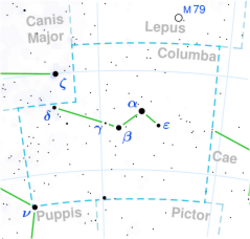Astronomy:HD 36187
| Observation data Epoch J2000.0 Equinox (celestial coordinates) | |
|---|---|
| Constellation | Columba |
| Right ascension | 05h 28m 15.33500s[1] |
| Declination | −37° 13′ 50.7477″[1] |
| Apparent magnitude (V) | 5.55±0.01[2] |
| Characteristics | |
| Evolutionary stage | main sequence star[3] |
| Spectral type | A1 V[4][5] |
| B−V color index | +0.02[6] |
| Astrometry | |
| Radial velocity (Rv) | 50±2[7] km/s |
| Proper motion (μ) | RA: +10.887[1] mas/yr Dec.: +68.709[1] mas/yr |
| Parallax (π) | 11.5707 ± 0.0576[1] mas |
| Distance | 282 ± 1 ly (86.4 ± 0.4 pc) |
| Absolute magnitude (MV) | +0.84[8] |
| Details | |
| Mass | 2.3+0.15−0.12[9] M☉ |
| Radius | 2.43±0.12[10] R☉ |
| Luminosity | 48±2[3] L☉ |
| Surface gravity (log g) | 4.10±0.14[9] cgs |
| Temperature | 9,513±21[11] K |
| Metallicity [Fe/H] | −0.16[12] dex |
| Rotational velocity (v sin i) | 145[13] km/s |
| Age | 311+83−149[9] Myr |
| Other designations | |
| Database references | |
| SIMBAD | data |
HD 36187, also known as HR 1835, is a solitary,[15] bluish-white hued star located in the southern constellation Columba, the dove. It has an apparent magnitude of 5.55,[2] making it faintly visible to the naked eye under ideal conditions. Based on parallax measurements from the Gaia spacecraft, it is estimated to be 282 light years away from the Solar System.[1] However, it is receding rapidly with a heliocentric radial velocity of 50 km/s.[7] At its current distance, HD 36187's brightness is diminished by 0.21 magnitude due to interstellar dust.[16]
HD 36187 has a stellar classification of either A1 V[4][5] or A0 V,[17] depending on the source. Nevertheless, both classes indicate that it is an ordinary A-type main-sequence star that is fusing hydrogen in its core. It has double the mass[9] and radius of the Sun.[10] It radiates 48 times the luminosity of the Sun[3] from its photosphere at an effective temperature of 9,512 K.[11] HD 36187 is estimated to be 311 million years old,[9] having completed 66.9% of its main sequence lifetime.[3] Like many hot stars HR 1835 spins rapidly, having a projected rotational velocity of 145 km/s.[13]
References
- ↑ 1.0 1.1 1.2 1.3 1.4 Vallenari, A. et al. (2022). "Gaia Data Release 3. Summary of the content and survey properties". Astronomy & Astrophysics. doi:10.1051/0004-6361/202243940 Gaia DR3 record for this source at VizieR.
- ↑ 2.0 2.1 Høg, E.; Fabricius, C.; Makarov, V. V.; Urban, S.; Corbin, T.; Wycoff, G.; Bastian, U.; Schwekendiek, P. et al. (March 2000). "The Tycho-2 catalogue of the 2.5 million brightest stars". Astronomy and Astrophysics 355: L27–L30. ISSN 0004-6361. Bibcode: 2000A&A...355L..27H.
- ↑ 3.0 3.1 3.2 3.3 Zorec, J.; Royer, F. (January 2012). "Rotational velocities of A-type stars IV: Evolution of rotational velocities". Astronomy & Astrophysics 537: A120. doi:10.1051/0004-6361/201117691. ISSN 0004-6361. Bibcode: 2012A&A...537A.120Z.
- ↑ 4.0 4.1 Cucchiaro, A.; Macau-Hercot, D.; Jaschek, M.; Jaschek, C. (July 1978). "Spectral classification from the ultraviolet line features of S2/68 spectra. III. Early A-type stars.". Astronomy and Astrophysics Supplement Series 33: 15–26. ISSN 0365-0138. Bibcode: 1978A&AS...33...15C.
- ↑ 5.0 5.1 Abt, Helmut A.; Morrell, Nidia I. (July 1995). "The Relation between Rotational Velocities and Spectral Peculiarities among A-Type Stars". The Astrophysical Journal Supplement Series 99: 135. doi:10.1086/192182. ISSN 0067-0049. Bibcode: 1995ApJS...99..135A.
- ↑ Johnson, H. L.; Mitchell, R. I.; Iriarte, B.; Wisniewski, W. Z. (1966). "UBVRIJKL Photometry of the Bright Stars". Communications of the Lunar and Planetary Laboratory 4: 99–110. Bibcode: 1966CoLPL...4...99J.
- ↑ 7.0 7.1 Kharchenko, N.V.; Scholz, R.-D.; Piskunov, A.E.; Röser, S.; Schilbach, E. (November 2007). "Astrophysical supplements to the ASCC-2.5: Ia. Radial velocities of ~55000 stars and mean radial velocities of 516 Galactic open clusters and associations". Astronomische Nachrichten 328 (9): 889–896. doi:10.1002/asna.200710776. ISSN 0004-6337. Bibcode: 2007AN....328..889K.
- ↑ Anderson, E.; Francis, Ch. (May 2012). "XHIP: An extended hipparcos compilation". Astronomy Letters 38 (5): 331–346. doi:10.1134/S1063773712050015. ISSN 1063-7737. Bibcode: 2012AstL...38..331A.
- ↑ 9.0 9.1 9.2 9.3 9.4 David, Trevor J.; Hillenbrand, Lynne A. (12 May 2015). "The Ages of Early-type Stars: Strömgren Photometric Methods Calibrated, Validated, Tested, and Applied to Hosts and Prospective Hosts of Directly Imaged Exoplanets". The Astrophysical Journal 804 (2): 146. doi:10.1088/0004-637X/804/2/146. Bibcode: 2015ApJ...804..146D.
- ↑ 10.0 10.1 Kervella, P.; Thévenin, F.; Di Folco, E.; Ségransan, D. (October 2004). "The angular sizes of dwarf stars and subgiants". Astronomy & Astrophysics 426 (1): 297–307. doi:10.1051/0004-6361:20035930. ISSN 0004-6361. Bibcode: 2004A&A...426..297K.
- ↑ 11.0 11.1 Paunzen, E.; Schnell, A.; Maitzen, H. M. (October 2006). "An empirical temperature calibration for the Δa photometric system II: The A-type and mid F-type stars". Astronomy & Astrophysics 458 (1): 293–296. doi:10.1051/0004-6361:20064889. ISSN 0004-6361. Bibcode: 2006A&A...458..293P.
- ↑ Anders, F. et al. (August 2019). "Photo-astrometric distances, extinctions, and astrophysical parameters for Gaia DR2 stars brighter than G = 18". Astronomy & Astrophysics 628: A94. doi:10.1051/0004-6361/201935765. ISSN 0004-6361. Bibcode: 2019A&A...628A..94A.
- ↑ 13.0 13.1 Royer, F.; Gerbaldi, M.; Faraggiana, R.; Gómez, A. E. (January 2002). "Rotational velocities of A-type stars". Astronomy & Astrophysics 381 (1): 105–121. doi:10.1051/0004-6361:20011422. ISSN 0004-6361. Bibcode: 2002A&A...381..105R.
- ↑ "HD 36187". SIMBAD. Centre de données astronomiques de Strasbourg. http://simbad.u-strasbg.fr/simbad/sim-basic?Ident=HD+36187.
- ↑ Eggleton, P. P.; Tokovinin, A. A. (11 September 2008). "A catalogue of multiplicity among bright stellar systems". Monthly Notices of the Royal Astronomical Society 389 (2): 869–879. doi:10.1111/j.1365-2966.2008.13596.x. ISSN 0035-8711. Bibcode: 2008MNRAS.389..869E.
- ↑ Gontcharov, George A.; Mosenkov, Aleksandr V. (28 September 2017). "Verifying reddening and extinction for Gaia DR1 TGAS main sequence stars". Monthly Notices of the Royal Astronomical Society 472 (4): 3805–3820. doi:10.1093/mnras/stx2219. ISSN 0035-8711. Bibcode: 2017MNRAS.472.3805G.
- ↑ Houk, N. (1982). Michigan Catalogue of Two-dimensional Spectral Types for the HD stars. Volume III: Declinations −40° to −26°. Bibcode: 1982mcts.book.....H.
<ref> tag with name "Gould1879" defined in <references> is not used in prior text.
 |


